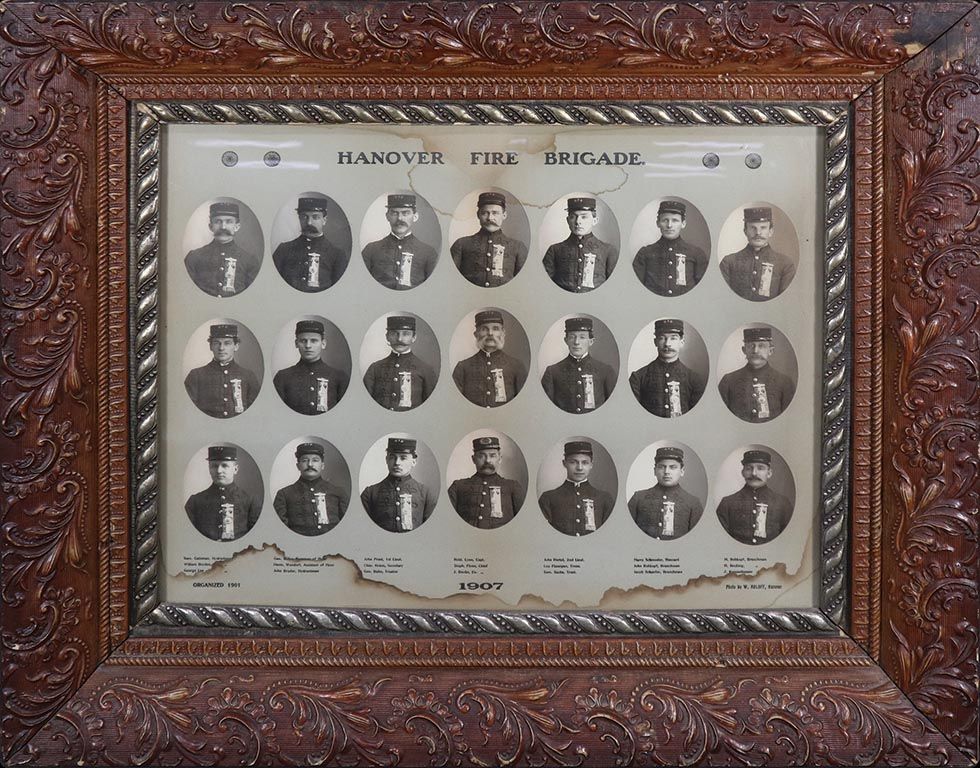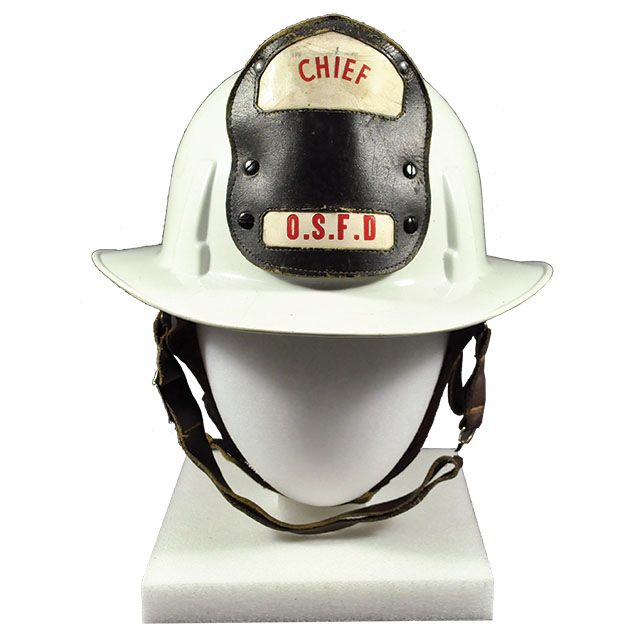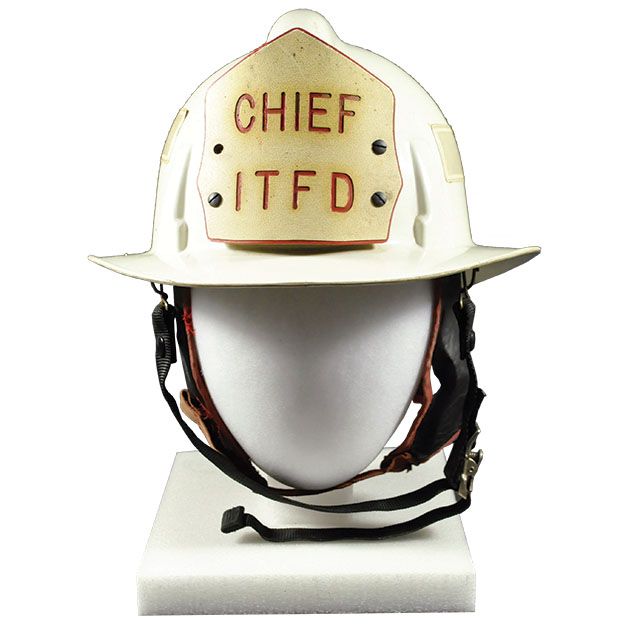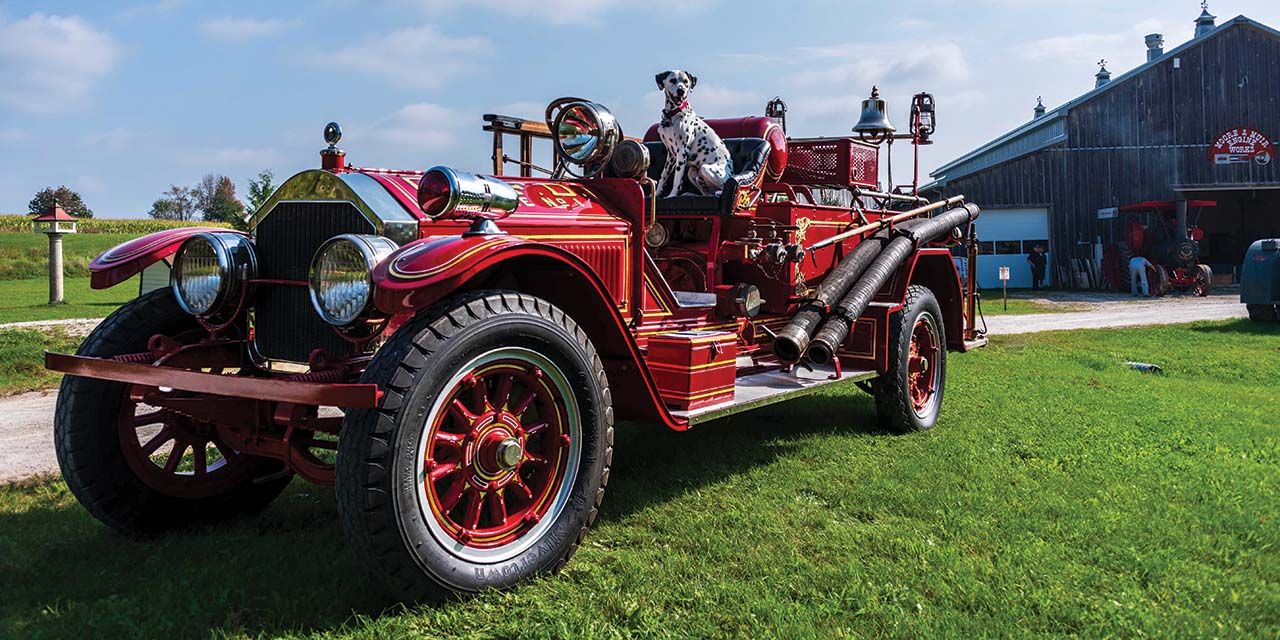Chief the dalmatian sits atop Grey Roots’ restored 1923 American LaFrance fire pumper. Grey Roots archival collection.
Facing the Flames:
The History of Firefighting in Grey County
By Cara Williams | Photography courtesy of Grey Roots Museum & Archives
In the heart of Grey County, a rich history of firefighting runs deep—from horse-drawn pumpers to modern fire trucks, local firefighters have battled blazes with courage and innovation for over 150 years.
When Owen Sound Fire Department Engine No. 1 roared back to life after decades of silence, it wasn’t just the powerful rumble of its engine that captured attention—it was the sound of history reigniting. Facing the Flames: The History of Firefighting in Grey County, winner of the 2019 Ontario Museum Association Award of Excellence for Community Engagement, originally began as an in-person exhibit at Grey Roots Museum & Archives in Owen Sound. Though the physical exhibit has concluded, it now lives on as an immersive virtual tour on the museum’s website (greyroots.com), portraying the evolution of firefighting in Grey County and honouring the men and women who battled blazes long before modern technology and digital alerts.
This long and storied history of firefighting in Grey County traces back to the earliest days of organized fire response. Owen Sound’s firefighting history began in 1850 when Village Council budgeted for fire buckets and appointed 30 men to form the first Volunteer Fire Brigade. In 1876, the Victoria Fire Department was established, initially operating from the Town Hall until moving to a dedicated facility in 1887.
![Fotoart Image - 010580[4561] web](https://media.publit.io/file/w_980,h_640,c_fit,q_80/Escarpment/fotoart-image-0105804561-web.jpg)
By 1900, Owen Sound’s volunteer fire department operated from a new hall housing horses, a steam engine, and hose reel, with the Police Court and Chief’s office upstairs. Grey Roots archival collection.
In 1890, the Excelsior Fire Department was formed, named after the insurance company responsible for its creation—a common practice at the time. A year later, the department acquired a second-hand 1874 horse-drawn steam pumping engine capable of expelling 1,135 litres (300 gallons) of water per minute. Alongside a ladder wagon, this significantly improved firefighting capabilities. Due to limited municipal resources, horses were rented from the market square during emergencies.
The Excelsior Fire Department disbanded in 1907, replaced by the paid Owen Sound Fire Department with four fulltime firefighters and ten on-call members. The transition to motorized firefighting began in 1918 with the purchase of the first motorized fire truck. In 1923, the department added Engine No. 1—a LaFrance Foamite chain-drive triple combination pumper, manufactured in Toronto and shipped by railway to Owen Sound. Engine No. 1 served fulltime until 1954, and then as a reserve engine until 1967. Its last significant operation was fighting the devastating City Hall fire in 1961. Donated to the museum in 2015, the engine underwent meticulous restoration by dedicated volunteers with significant labour and materials donations from Pete’s Autobody and Kuhl’s Machine Shop, eventually becoming the centrepiece of Facing the Flames.

After the devastating Knechtel’s Furniture fire in 1900, Hanover formed a volunteer fire brigade. By 1907, Fire Chief Stephen Flynn led the 21-member team. Photo: Hanover Fire Dept.
![AS2019.020.001 Clarksburg Fire Dept., [1965] - [1975] web](https://media.publit.io/file/w_980,h_768,c_fit,q_80/Escarpment/as2019-020-001-clarksburg-fire-dept-1965-1975-web.jpg)
Clarksburg firefighters with Pumper No. 2, circa 1960. At the time, they shared four sets of bunker gear, bundled on top of the truck. Front (l–r): Eldon Hawton, David Hammond, Gordon Marritt, Jack Phillips Centre (l–r): Ray Leclair, Sam Dinsmore, Bob Leclair, Murray Hammond, Michael Hammond, Wilbert Nelson, Don Hutchinson Back (l–r): Carman Marritt, Allan Lake Grey Roots archival collection.
The Facing the Flames exhibit was spearheaded by curator Sim Salata, whose research and dedication to uncovering the broader history of Grey County firefighting brought the project to life. “At the time, my role was to research and write the exhibit,” Salata recalls. “It was really interesting and quite challenging because, historically, most of the documentation Focused on the Owen Sound Fire Department. But for a county museum, we had to represent the entire region, which meant diving into records from Hanover, Durham, Thornbury, Meaford, and beyond.”
Much of that research was supported by the museum’s archives, along with contributions from local fire departments. Salata credits former assistant archivist Kate Jackson in the archives for assisting with digging through municipal bylaws and fire department records across the county. But one of the most pivotal moments in shaping the exhibit came when Salata was invited to present the idea at an inter-county fire chiefs’ meeting.
“Once they heard about the project, they were incredibly supportive,” she says. “They not only provided access to historical records but also opened the doors for me to interview firefighters and chiefs from across the region. I visited every fire department in Grey County, which really helped create a fuller picture of firefighting history beyond Owen Sound.”
![A2021.007.005 Owen Sound 2nd Ave E Businesses Reproduction [1920]-[1930] web](https://media.publit.io/file/w_980,h_640,c_fit,q_80/Escarpment/a2021-007-005-owen-sound-2nd-ave-e-businesses-reproduction-1920-1930-web.jpg)
By 1915, motor cars were emerging in Grey County, but Owen Sound firefighters still relied on horses, seen here galloping past the Paterson House Hotel on 2nd Avenue East. Grey Roots archival collection.
One of the defining elements of the exhibit was its artifacts. While Grey Roots had a modest collection of fire-related memorabilia, the exhibit truly took shape when the Owen Sound Fire Department donated its first fire pumper. “That was really the catalyst for the exhibit,” Salata explains. “Our volunteers spent three or four years restoring it, and when it was finally ready, we knew we had to showcase it properly.”
In addition to the fire pumper, retired firefighters from across the county began contributing personal artifacts. “We had people bringing in old helmets, coats, and belts that had been tucked away for decades. Some of the most fascinating pieces were the early firefighting coats—before modern PPE, they essentially wore black rubber rain gear,” Salata notes. “One firefighter even donated a helmet that had been dented when a roof collapsed on him. These pieces weren’t just historical objects; they told real stories of the risks firefighters took.”
Facing the Flames opened in September 2019 and was originally intended to run for a year. However, due to COVID-19 shutdowns, it remained installed until January 2022, though periods of closure meant many visitors missed seeing it in person. Fortunately, the exhibit was digitally preserved through an online tour, ensuring its legacy endures.
As visitors explore the virtual corridors of the exhibit, the story unfolds like a gripping historical journey. Early volunteer brigades, armed with little more than basic tools and sheer determination, laid the foundation of Grey County’s fire service. Their bravery, often documented in local newspapers and passed down through generations, reflects a time when communities came together in the face of disaster.



Three plastic fire helmets on loan to Grey Roots from Owen Sound and Inter Township fire departments: a 1960s Mine Safety Appliances helmet, a 1989 Cairns & Brothers Model 660C, and another 1960s MSA helmet. Grey Roots Museum & Archives.
The exhibit weaves together archival photographs, handwritten documents, and interactive media to illustrate how firefighting has evolved over generations. It highlights the shift from simple bucket brigades to today’s well-coordinated response systems, emphasizing the dedication that has protected homes, businesses, and lives. “One of the most rewarding aspects of curating this exhibit was seeing how much coordination exists in today’s firefighting efforts,” Salata reflects. “Firefighting has always been about teamwork, but modern communication and interdepartmental collaboration have taken it to another level. That, to me, was one of the biggest takeaways from the project.”
Today, many of the artifacts from Facing the Flames remain in the museum’s collection, with some on display and others available for research. Grey Roots continues to be a steward of the county’s firefighting history, ensuring that the bravery and ingenuity of past and present firefighters are never forgotten.
What makes Grey County’s firefighting history particularly compelling is its intermingling with the cultural identity of the region. Fire has not merely been an adversary—it has also been a catalyst for resilience and innovation. The Facing the Flames exhibit captures the spirit of camaraderie that has flourished amidst adversity, portraying firefighters not just as warriors against flames but as integral figures in the ongoing story of local identity. E







